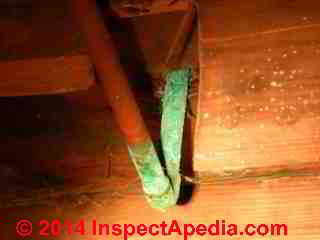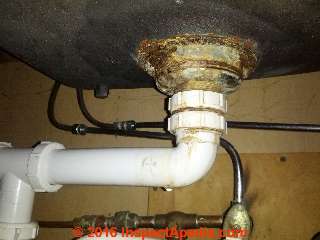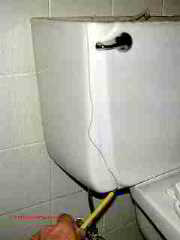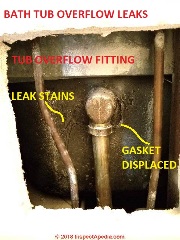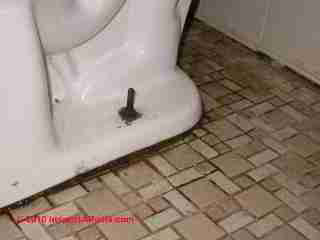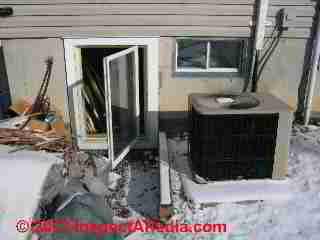 Types of Plumbing Leaks
Types of Plumbing Leaks
Plumbing Leak Diagnosis
Tips
- POST a QUESTION or COMMENT about types of leaks in supply & drain piping
Types of leaks in water supply or drain piping:
This article describes the different types of plumbing leaks that can occur in building supply piping or drain piping.
Knowing just what kind of leak is occurring in a building helps pinpoint the problem and also helps specify the necessary plumbing repair.
We discuss: Water supply pipe and well pipe leak types & diagnosis. Types of plumbing leaks helps find leaks in buildings. When where, why, and how to check for & fix water supply and drain leaks. How to de-winterize a building and restore the plumbing & heating systems to service
Watch out: a water supply leak, left un-attended, can cause catastrophic damage to a building, wetting floors, walls, ceilings, even filling a basement such as could have happened to the flood-damaged home in the photo above.
InspectAPedia tolerates no conflicts of interest. We have no relationship with advertisers, products, or services discussed at this website.
- Daniel Friedman, Publisher/Editor/Author - See WHO ARE WE?
Types of Water Supply & Drain Pipe Leaks - How to Find Plumbing Leaks in buildings
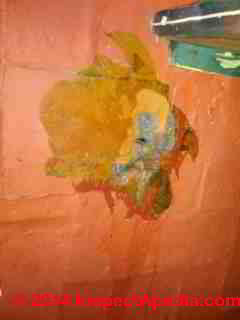 Understanding the types of water leaks that occur in building piping can help you find or watch out for leaks that are not so obvious when water is first turned on in a building. Keep in mind that these are by no means all of the building leaks that can occur.
Understanding the types of water leaks that occur in building piping can help you find or watch out for leaks that are not so obvious when water is first turned on in a building. Keep in mind that these are by no means all of the building leaks that can occur.
Others include leaky shower pans, leaky air conditioning condensate drains, bad sump pump drains, leaky water tanks, leaky water heaters, leaks at tankless coils, and leaks from outside the building from roof runoff or surface runoff. Here we describe the differen ttypes leaks that occur in building piping.
Understanding what's going on with a pipe leak can help avoid making matters worse as well as help directing the repair.
The water seeping from the paster wall shown at left was a leak that could teach us about water supply piping leaks and repairs: water was just seeping out of the wall until someone got curious and "poked" the wall to make a larger hole.
Then water came spewing out of the wall from a burst main water supply pipe connected to municipal water.
Don't do that! Fortunately someone had the presence of mind to jam a stick into the hole to reduce the rate at which the buildig was flooding. Details of this hullabaloo and how it was repaired are at REPAIR BURST LEAKY PIPES.
[Click to enlarge any image]
Types of Leaks in Water Supply Piping
- Gusher water supply pipe water leaks:
if a water supply pipe has burst, split, been cut open, or has separated at a solder joint, as soon as water is turned on to that area of the building the pipe will probably leak a lot of water very quickly: you will notice gusher leaks almost immediately by sound or by the visual evidence of water flooding or wetting some area of the building.
- Drip and pinhole water supply pipe leaks - Corrosion:
a small leak may be present at a water supply pipe such as from a loose threaded fitting, worn valve stem packing, or even a pinhole due to corrosion or due to a nail or screw having been driven into a supply pipe. These leaks can take a longer time to discover because the rate of leak is so slow.
Watch out: (Don't pull out that nail or screw when you find it until you've first shut off the water supply or a bigger leak will ensue
But these leaks normally are indeed discovered in days or weeks after they occur.
See DIELECTRIC FITTING CODES
Leaks in water supply pipes blamed on corrosion can also be caused by improper electrical grounding.
See ELECTRICAL GROUND PIPE CORROSION
Also see WELL PIPING LEAK DIAGNOSIS - Defective Water Pipe Material Leaks: corroded copper pipe leaks -
See details at LEAK INSPECTION of WATER SYSTEMS -
or defective plastic pipe or plastic pipe fitting leaks -
See those details at PLASTIC PIPE LEAK CAUSES - Plumbing Fitting Leaks -
can occur if a fitting, coupling or union for example, is not properly soldered, tightened or if a threaded fitting was installed without proper seralant.
We also find leaks at plumbing supply pipe connections and fittings when dis-similar metals are joined without a diaelectric fitting.
See DIELECTRIC FITTING CODES
See also PEX BRASS CONNECTOR LEAKS
Types of Leaks in Building Drain Piping
- Plumbing drain leaks:
plumbing drain leaks are a bit like our hidden water faucet leak: they only show up if the particular leaky drain is carrying wastewater.
For example, a leaky shower trap in an upstairs shower may go unnoticed for a long time if it's the guest-bath shower that is rarely used.
Except where the drain pipes are visible, such as in a basement or crawl space, plumbing drain leaks may be slow to appear and show up as a stain in a ceiling or wall below the offending drain, or as mold or mold odors in a building.
Of course if a plumbing drain has literally burst or fallen open the leak will be enormous and will show up quickly as was the case with our gusher water pipe leaks described above. - Sink basin or sink strainer leaks:
leaks also occur at the drain assembly of all types of sinks due to improper installation, loose parts, missing gaskets or sealant, or from corrosion.
Watch out: a corroded leaky sink strainer or sink stopper assembly can leak sending water down the exterior of the drain piping where it may be mistaken for a drain pipe leak.
See SINK LEAK DIAGNOSIS & REPAIR
Also see THAWING FROZEN PIPES which addresses how to find frozen and burst pipe leaks in buildings,
and
see REPAIR BURST LEAKY PIPES
Types of Leaks at Plumbing Fixtures
Plumbing fixtures (sinks, tubs, showers, toilets) may produce other leaks that are not due to a leaky water supply or drain pipe leak. Here are some examples to look for:
- Cracked fixture leaks: leaks may occur if a vitreous china plumbing fixture is cracked. A broken, cracked toilet tank like the one I show above can flood a home. This one did.
See TOILET LEAK CATASTROPHES
- Bath tub or sink overflow leaks:
these fixtures can overflow into the building if water if the fixture drain is closed and the fixture is left unattended. Modern sinks and tubs include an overflow opening that is designed to send water into the fixture drain system if the fixture water level is too high.
Some older plumbing fixtures lack this feature and have no overflow provision.
On occasion we find that even though the fixture has an overflow drain opening, that opening is blocked, or in the case of bath tubs, the overflow drain was never properly connected to the tub drain system.
The photo above shows a bathtub overflow fitting from the wall cavity side. We cut this opening to permit repairs after water from the bath tub appeared in the ceiling of the room below.
We found two leaks:
Episodic leaks at the bath tub
occurred when the bath tub was filled to the height of the overflow (or when shower water splashed around the overflow). The gasket had long dried out and was dislocated. Click to enlarge the photo and you'll see leak stains on the tub surface.
Every-use leaks at the bath tub:
The second leak was due to loose trap fittings below the bath tub.
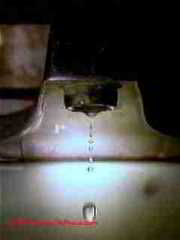 Faucet leaks: sink, tub, shower, or laundry sink faucets may leak continuously by dripping into the fixture sending that water down the drain system.
Faucet leaks: sink, tub, shower, or laundry sink faucets may leak continuously by dripping into the fixture sending that water down the drain system.
But such leaks can still cause problems by flooding a septic system (in severe cases) or by causing freeze damage to drain pipes in cold climates.
- A visible water faucet leak
is one that shows up where you can see it, such as dripping into the sink, tub, or shower around the faucet control when the control is opened, but stopping when the faucet is shut.
Or the faucet may drip continuously because the faucet washer or the base against which the washer seals has been damaged or is worn-out. - Leaks-when-on Devils: hidden water faucet leak
is much more sneaky.
Particularly at tub and shower controls mounted on a vertical wall, some faucets may leak inside of the wall cavity only when the faucet is open and water is running.
Because these leaks are usually just a slow drip, the leak may be present for months or even longer before it is finally noticed
Typically these surreptitious faucet leaks show up as a stain in a ceiling below the fixture or as mold or moldy odors in a building. Opening a wall or ceiling cavity may be necessary to find and repair such leaks.
We call these Leaks-when-on devils because the fitting or fixture leaks only when the fixture is turned on, and worse, at a tub or shower control the leaks when on type leak occurs inside of a wall or ceiling or floor where it's hidden until water stains or mold make it evident that there's a problem.
A more odious faucet leak can occur when the faucet valve stem packing fails.
- Plumbing fixture control valve stem leaks:
sometimes a sink, tub, or shower faucet develops a leak, usually around the valve stem packing, that will leak only when the valve is in the open position - that is, when water is running at that faucet. These leaks fall in two sub-classes: visible and hidden.
Faucet valve stem leaks at a bath, kitchen or laundry sink can send water across the fixture top surface, onto counters, into cabinets, onto or into floors.
A similar odious tub or shower control leak can send water dripping into the wall or floor cavity.
See DRIPPING WATER SOUND SOURCES
See FAUCETS & CONTROLS, KITCHEN & BATH - Sink strainer assembly leaks:
occur at kitchen or bath or laundry sinks when a gasket or sealant is missing or defective or when the strainer assembly corrodes.
See SINK LEAK DIAGNOSIS & REPAIR - Toilet overflow leaks:
occur because of a blocked drain or because the toilet tank fill valve and internal toilet tank overflow tube are not working or are not properly installed.
See TOILET CLOG REPAIR, UN-BLOCK
See TOILET OVERFLOW EMERGENCY
- Loose toilet base leaks:
toilet may wobble on its base which is a sure sign that it's going to leak into the floor when the toilet is flushed.
But even a toilet that doesn't wobble may leak into the floor if the wax ring seal between toilet and drain pipe is missing or improperly installed.
These leaks will accumulate on the floor or below the floor, appearing perhaps also on the ceiling below. They occur each time the toilet is flushed, or they may be continuous if the toilet is running.
See LEAKY TOILET SEALS, ODORS
See LOOSE TOILET REPAIRS - Running Toilet Leaks:
a toilet that runs continuously can cause a range of leak problems including- Condensation or "sweating" on the toilet tank that drips onto the floor below
- Sewage backup leaks if the running toilet causes a septic drainfield failure
- Sewage backup leaks
if the running toilet causes the building main to freeze up (in freezing climates only)
See DRAIN FREEZE PROTECTION
See TOILET RUNS CONTINUOUSLY
Well Piping Leaks
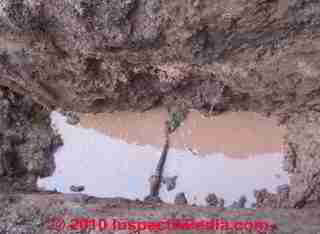 Our article on this topic is found at WELL PIPING LEAK DIAGNOSIS. Excerpts are below.
Our article on this topic is found at WELL PIPING LEAK DIAGNOSIS. Excerpts are below.
Well pipe leaks can be tricky to find as the pipe is usually buried for most or even all of its course between well and building. However there are symptoms that can point to a well pipe leak.
Water will leak out of a well pipe
at a bad connection, perforation, or cracked pipe when the well pump is running, particularly if the water system uses a submersible pump that is located in the well itself.
If you have this problem you may find a wet spot in the ground near the well piping, provided that the pipe is close enough to the surface.
You will also notice that the well pump is running more often than normal, and that your "apparent" water usage may have increased. Some people even report finding a "water fountain" or geyser in the lawn at a burst water supply pipe from both private wells and from a municipal water main.
Air may leak into a well water pipe
at a bad connection, perforation, or other damage when the well pump stops running, particularly if the leak problem is combined with a defective check valve or foot valve in the piping system.
The result may be air discharged from plumbing fixtures, improper air charge in the water pressure tank, or loss of pump prime. Short cycling of the water pump or loss of pump prime may result as well.
See details at AIR DISCHARGE at FAUCETS, FIXTURES
At WATER PRESSURE PROBLEM DIAGNOSIS TABLE we note that a possible explanation for loss of building water pressure, or loss of well pump prime can be air leaking into a well piping line, as well as water leaking out of the well pipe.
...
Continue reading at REPAIR BURST LEAKY PIPES or select a topic from the closely-related articles below, or see the complete ARTICLE INDEX.
Or see LEAK TYPES SUPPLY or DRAIN PIPE FAQs - questions & answers posted originally at this article.
Or see these
Recommended Articles
- DRIPPING WATER SOUND SOURCES
- FAUCETS & CONTROLS, KITCHEN & BATH
- LEAK CAUSES in WATER PIPING - what causes leaks in metal piping?
- LEAK TYPES, WATER SUPPLY or DRAIN PIPES
- MOISTURE METER STUDY - how to use a moisture meter to check for leaks
- PLUMBING LEAK DETECTION METHODS
- PLUMBING LEAK DETECTION & SHUTOFF DEVICES
- PLUMBING LEAKS: SEWER LINE LEAKS & ODORS
- PLUMBING SYSTEM PRESSURE TESTS
- THAWING FROZEN PIPES how to find frozen and burst pipe leaks in buildings without causing a catastrophe
- WELL PIPING LEAK DIAGNOSIS - how to figure out if there is a leak in the well piping system
Suggested citation for this web page
LEAK TYPES, WATER SUPPLY or DRAIN PIPES at InspectApedia.com - online encyclopedia of building & environmental inspection, testing, diagnosis, repair, & problem prevention advice.
Or see this
INDEX to RELATED ARTICLES: ARTICLE INDEX to PLUMBING SYSTEMS
Or use the SEARCH BOX found below to Ask a Question or Search InspectApedia
Ask a Question or Search InspectApedia
Try the search box just below, or if you prefer, post a question or comment in the Comments box below and we will respond promptly.
Search the InspectApedia website
Note: appearance of your Comment below may be delayed: if your comment contains an image, photograph, web link, or text that looks to the software as if it might be a web link, your posting will appear after it has been approved by a moderator. Apologies for the delay.
Only one image can be added per comment but you can post as many comments, and therefore images, as you like.
You will not receive a notification when a response to your question has been posted.
Please bookmark this page to make it easy for you to check back for our response.
IF above you see "Comment Form is loading comments..." then COMMENT BOX - countable.ca / bawkbox.com IS NOT WORKING.
In any case you are welcome to send an email directly to us at InspectApedia.com at editor@inspectApedia.com
We'll reply to you directly. Please help us help you by noting, in your email, the URL of the InspectApedia page where you wanted to comment.
Citations & References
In addition to any citations in the article above, a full list is available on request.
- "New Electric Heat Tapes Help Prevent Fires," US Consumer Product Safety Commission (CPSC) #00936
- Mark Cramer Inspection Services Mark Cramer, Tampa Florida, Mr. Cramer is a past president of ASHI, the American Society of Home Inspectors and is a Florida home inspector and home inspection educator. Mr. Cramer serves on the ASHI Home Inspection Standards. Contact Mark Cramer at: 727-595-4211 mark@BestTampaInspector.com
- John Cranor [Website: /www.house-whisperer.com ] is an ASHI member and a home inspector (The House Whisperer) is located in Glen Allen, VA 23060. He is also a contributor to InspectApedia.com in several technical areas such as plumbing and appliances (dryer vents). Contact Mr. Cranor at 804-873-8534 or by Email: johncranor@verizon.net
- "Freezeproof Your House," Mike McClintock, Rodale's New Shelter, p. 30, October 1985 (approximate date)
- "How to Winterize Your Pipes," Mike McClintock, Homeowners How-To Magazine, p. 59-62, Nov-Dec 1979.
- Thanks to reader Dan Babb for discussing well piping leaks, July 2010
- In addition to citations & references found in this article, see the research citations given at the end of the related articles found at our suggested
CONTINUE READING or RECOMMENDED ARTICLES.
- Carson, Dunlop & Associates Ltd., 120 Carlton Street Suite 407, Toronto ON M5A 4K2. Tel: (416) 964-9415 1-800-268-7070 Email: info@carsondunlop.com. Alan Carson is a past president of ASHI, the American Society of Home Inspectors.
Thanks to Alan Carson and Bob Dunlop, for permission for InspectAPedia to use text excerpts from The HOME REFERENCE BOOK - the Encyclopedia of Homes and to use illustrations from The ILLUSTRATED HOME .
Carson Dunlop Associates provides extensive home inspection education and report writing material. In gratitude we provide links to tsome Carson Dunlop Associates products and services.


